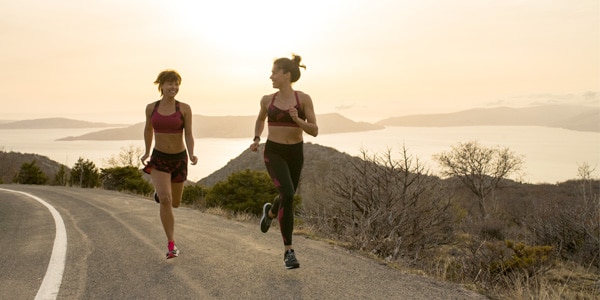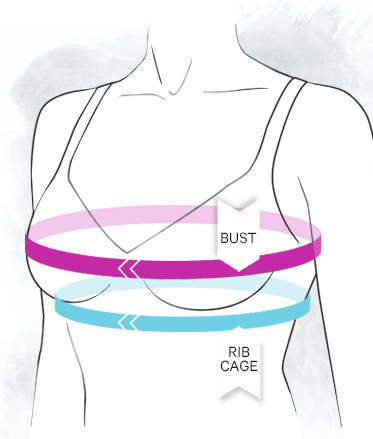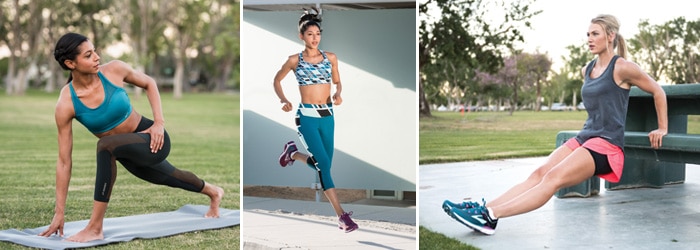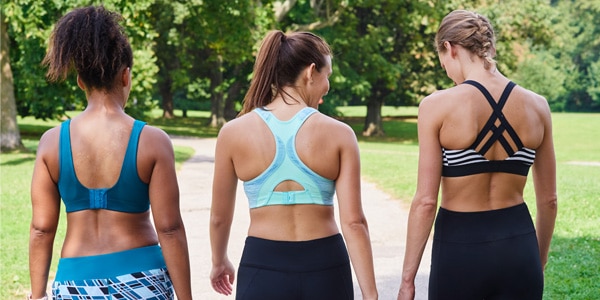Have you ever experienced the drawbacks of an ill-fitting and underachieving sports bra? If so, you are not alone!
Statistics show that at least half of women are in the wrong one. This is largely because finding the right sports bra is a challenge. There are many factors to consider and an abundance of varying styles, materials, and brands to contemplate. Not to mention, when you finally find a sports bra that feels supportive in-store – it can often underperform when put into action.
As many women can attest, exercising in a sports bra that is too loose can cause digging straps, painful bounce, and tense shoulders. Training in one that is too tight, can result in chafing and restricted breathing. According to science, a sports bra that lacks adequate support to reduce breast movement can damage soft tissue over time. Besides properly fitted running shoes, as a woman, a properly fitting sports bra is the most important and personal piece of workout gear you shouldn’t do without.

We’d like to take the guesswork out of finding you the right fit. Just as we have a fit process for shoes, we also have a fit process for sports bras. Curious about what this fit process entails? Read on for our guide on finding your perfect fit!
How To Find The Right Sports Bra
The first part in our sports bra fit process is to determine your size by taking two quick measurements. All measurements can be comfortably taken over clothing. For accuracy, consider wearing a regular bra that maintains your natural shape with little to no padding or minimizing features.

1.Measure your rib cage
The first measurement is taken around your rib cage around where the bottom band would sit. The tape measure should feel quite snug. Then the measurement is rounded down to the closest inch.
2. Measure your bust
The second measurement is taken of the bust, also known as the fullest point of the breast. Sometimes the fullest point may not be at the center, which is completely normal. As breast tissue can fluctuate as much as 20%, we round up to the closest inch.
3. Determine your primary activity
The next step is to determine the type of activity you will be doing, this largely dictates the level of support you will need. The three levels of support are described as: Low, Medium, and High Impact. Our fit experts can show you which bras fall into the support category you desire. Generally, the following activities require the associated levels of support.
Low Impact: Yoga, Pilates, climbing, paddling
Medium Impact: Walking, road biking, skiing
High Impact: Running, boot camp, mountain biking
4. What features and styles do you Need?
Compression or Encapsulation? Once you’ve found the appropriate size and support level, it’s time to talk about the difference between compression and encapsulation. In a nutshell, compression bras minimize bounce by hugging your bust close to your chest with stretch fabric. Encapsulation sports bras use a different strategy. By supporting your bust from beneath with separate molded cups, like a regular bra, they provide more effective motion control. Compression style bras are usually best for A and B cups and encapsulation sports bras are a better match for C and D cups.
Underwire or Padded Cups? Just like your everyday, nonathletic bra, some sports bras feature wired cups for support. You’ll typically find them in medium to high-impact bras designed for decreasing movement during exercise. The drawback is that some women find that they don’t move with your body as well as wireless versions. Those seeking an underwire alternative should try a sports bra with a molded-cup (encapsulation) design.
Pullover or Back Closure? Pullover styles typically cover the back more than back closures; however, they lack the adjustability and support that is vital for high impact activities. Pullovers are great for low impact activities while back closures let you tighten the band, depending on the support you need.
Adjustable Straps? Adjustable straps are a fantastic feature that allows you to find your perfect strap length and prevent the straps from cutting into your shoulders. Similar to back closures, adjustable straps provide a customized fit.
Luckily, when it comes to these support features, you don’t have to pick just one. The best bras out there will use a mix of these to provide optimal support and comfort for you during your workouts.
5. Perform a couple of tests Yourself
Besides being correctly sized, choosing the right support level, and having the optimal features, how else can you be confident that your sports bra will hold up during activity? You can perform 3 simple tests to gauge motion control, fit, and support.
Strap Test: Hold the top of one strap and the center of the corresponding cup, then pull. Whether they’re adjustable or not, the less stretchy the front straps, the more motion control they’ll provide.
Cup Test: Repeat a similar stretch test by gently tugging the top and bottom of each cup. Less give equals more motion control. When trying on the bra in the dressing room, whether it is a compression or encapsulation style, the cup should hold the whole breast. If it doesn’t, choose the next larger cup size.
Band and Side Panel Test: With the sports bra on, place a finger under the front of the band and check to make sure you cannot pull it more than an inch from your chest. (Expert tip: For an adjustable band style, set the clasp on the first eyelet; if you have to use the last eyelet to get a snug fit, you’re better off with a smaller band.) Next, reach your arms overhead; if the band creeps up, it’s too big.
6. You know best!
In the end, you are the only expert who can say what’s best for your body. We know that fit and comfort can be a personal choice, so don’t be shy about asking questions and trying a bunch of different styles and support levels. The goal is for you to be comfortable (& completely supported) in doing the activities you love!
Tips for Bra care:
- Wash the bra in cold water with mild detergent. Avoid fabric softener and bleach.
- Let it air dry when you can. For the dryer, use the cold tumble cycle only. Heat breaks down spandex.
- Replace the bra if the ends of the spandex fibers start showing or the fabric no longer snaps back into shape. (Average lifespan: nine to 15 months of regular wear.)
Written by: Rachel Donovan – Guest Advocate & Facebook Content Manager




